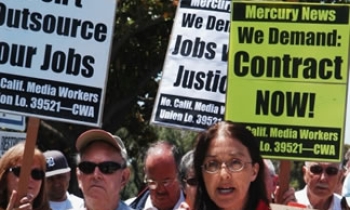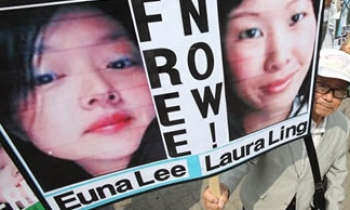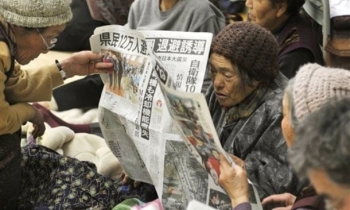The St. Paul Pioneer Press will eliminate the equivalent of 40 full-time jobs after seeing ad revenue drop in key categories, a trend that accelerated in recent months.
The jobs will be cut through a combination of attrition, buyouts and layoffs. The newsroom, the paper's single largest department, will cut the equivalent of 20 full-time positions. The other cuts will be spread across the newspaper.
The changes will come quickly, as buyout applications will be due on Nov. 27 and people who get them could be out the door by Dec. 1.
As people indicate they want to take a buyout, the paper will have the ability to be selective about who gets the packages based on applicants' skills and other criteria. "If every photographer said they'd take a buyout, we'd have to be smart about how we go down in size," said Par Ridder, the paper's publisher. "Our challenge here is to not torpedo the business."
The paper currently employs 745 people and the reductions represent about 5 percent of that work force.
The paper's revenue decline results largely from decisions made by advertisers who buy national ads for products such as cars and cell phones. Those companies, including domestic automakers, are spending more of their ad money pursuing buyers online, Ridder said.
The trend already has hit a number of newspapers nationally, and a wave of layoff announcements has swept across the industry in recent weeks.
At meetings with employees, Ridder was asked if this set of cuts would be the only reductions at the Pioneer Press, and what the prospects are for ad revenue rebounding. He said he couldn't predict where the business would go.
"There isn't some plan that's sitting in my desk that I'm not telling you about," he said, noting that the advertising trend playing out in St. Paul is not unique. "It's time to think of why you're in the news business," he told employees. "Where do you stand in the organization going forward?"
The buyout package includes two weeks of pay for each year of employment at the paper and health care coverage for up to six months. Health coverage would be available for another year after that, though at a higher cost to the employee.
The Pioneer Press' former owner, Knight Ridder Inc., sold the paper earlier this year. The paper is currently owned by the Hearst Corp. but is managed by MediaNews Group Inc., which eventually plans to own it outright after its financing deal with Hearst is complete.
Asked if the new owners were responding differently to the revenue crunch, Ridder said he didn't think things would have been much different under Knight Ridder. It's all the result of the ad-revenue decline.
"I've never seen numbers like this before," Ridder said.
The Pioneer Press newsroom is trying to reach its target of 20 positions through at least 10 buyouts, a cut in the number of on-call employees used to staff its copy desk, and open positions that won't be filled. If not enough people take buyouts, employees will be laid off.
"The fact that they're voluntary is certainly better than seeking them in an involuntary way," said Jack Sullivan, unit secretary for the union that represents newsroom employees. "Hopefully, we'll get them."
After the reductions are made, "I still think we can produce that local newspaper that people want to buy," said Thom Fladung, the newspaper's editor. There also are plans in the coming year to add a couple of positions that will work on the paper's Web site.
Some employees who sat through the presentations Monday described it as depressing.
"We've gone through getting over this trauma of being sold and then sold again, now we're being confronted with this," said Joe Rossi, a photographer at the paper. He's 53, has been at the newspaper for 23 years, and says he's not close enough to retirement to consider a buyout.
He's also worried about the way union contract negotiations are going at the San Jose Mercury News, another paper that MediaNews Group Inc. bought recently after Knight Ridder was broken up. At that paper, MediaNews has said jobs will be cut soon if the union doesn't accept an offer that's on the table, which includes wage cuts for new employees. The Pioneer Press' union contract for members of the Newspaper Guild is up next summer.
Monday's news "isn't the sort of morale booster we needed right now," Rossi said.
The Pioneer Press and the Guild also are in a legal battle over the paper's pension plan, which is projected to be underfunded by about $22 million by 2009. The company wants to freeze the pension benefits and a judge's ruling on the case is expected soon.
A freeze means employees wouldn't accrue further benefits for years of service although they continue to work at the paper.
Starting in July, advertising numbers for newspapers started to get much weaker than anyone anticipated, said John Morton, a newspaper industry analyst. The decline accelerated as the months went by.
The upside of the ongoing shift to online advertising is that newspapers are getting more than their share of those ads on their Web sites. But typically, those online ads account for only 5 percent to 6 percent of a paper's total ad revenues, he said.
The job that newspapers do — gathering mass amounts of local information — isn't done by anybody else, Morton said. "But the problem is that the economic model for doing that all resides in the print product, and it's print that is under stress."
John Welbes can be reached at jwelbes@pioneerpress.com or 651-228-2175.









